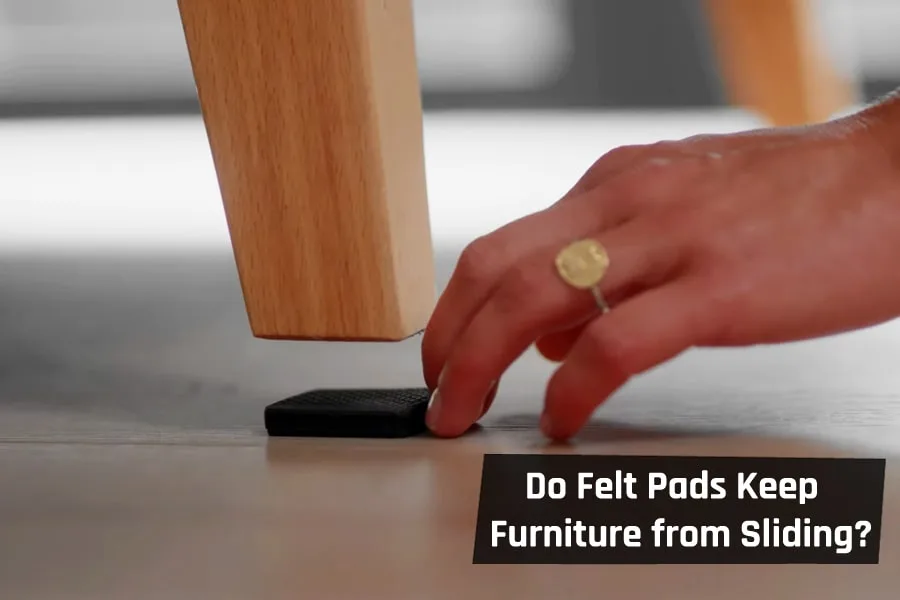Felt pads are a popular solution for preventing furniture from sliding, especially for lighter chairs.
Despite concerns about wear and maintenance, some users find success with adhesive felt pads, noting their durability and the ability to keep furniture in place on hardwood floors.
In a home with recently restained classic hardwood floors, the need to protect against furniture scratches arises.
While one user expresses reservations about traditional felt pads due to wear and dirt accumulation, another recommends plastic pads with a Teflon wear surface for chairs, acknowledging that felt is suitable for furniture.
- Felt pads are effective for preventing furniture sliding, especially for lighter chairs. However, there are concerns about durability and maintenance
- Alternatives to felt pads include furniture sliders, rubber pads, Teflon glides, cork pads, and chair glides.
The effectiveness of felt pads varies based on usage, with some experiencing longevity and minimal issues. Ultimately, the choice between felt and alternative materials depends on specific considerations such as the type of furniture and floor surfaces.

What are the Types of Felt Pads?
Felt pads come with 4 different types. Find their characteristics from the below table.
| Felt Pads Type | Material | Effectiveness | Suitability |
| Adhesive Felt Pads | Felt material with adhesive backing | Effective in preventing scratches and minimizing noise. | Suitable for various floor types (hardwood, laminate, tile) and lighter furniture items such as chairs and tables. |
| Nail-On Felt Pads | Felt material with a nail or screw attachment | Durable and stable, offering secure attachment. Effective in preventing scratches and reducing noise. | Suitable for hardwood and solid surfaces. Ideal for heavier furniture items like sofas and cabinets. |
| Slip-On Felt Pads | Soft, durable felt material | Effective in preventing scratches and dampening noise. | Versatile, suitable for various floor types (hardwood, laminate, tile) and a range of furniture items, including chairs and tables. |
| Self-Adhesive Furniture Felt Strips | Felt material with adhesive backing | Provides a continuous surface for furniture contact, preventing scratches and reducing noise. | Suitable for various floor types. Customizable for different furniture shapes and sizes, commonly used for chairs, tables, and larger furniture items with straight legs. |
What are the Pros and Cons of Felt Pads
Felt pads are commonly used to protect floors and furniture from scratches and damage caused by movement. While they offer several advantages, there are also drawbacks associated with their use.
Pros
- Scratch Prevention: Felt pads effectively prevent scratches and scuffs on various floor surfaces, particularly hardwood and laminate. They act as a protective barrier between furniture legs and floors.
- Noise Reduction: Felt pads can reduce the noise produced when furniture is moved. This is especially beneficial in homes or offices where noise reduction is a priority, creating a quieter environment.
- Easy to Install: Installation of felt pads is straightforward and does not require professional assistance. They often come with adhesive backing, allowing users to easily attach them to the bottom of furniture legs.
- Versatility: Felt pads are versatile and come in various sizes and shapes to suit different types of furniture. They can be easily trimmed or adjusted to fit specific leg dimensions.
- Affordability: Felt pads are generally cost-effective, making them an affordable solution for protecting floors and extending the lifespan of furniture.
- Aesthetically Pleasing: Felt pads are often inconspicuous and do not significantly alter the appearance of furniture. They provide protection without compromising the aesthetic appeal of the pieces.
Cons
- Wear and Tear: Over time, felt pads can wear out, especially in high-traffic areas. Constant movement and friction between the furniture and the floor may lead to the deterioration of the felt material.
- Accumulation of Dirt and Debris: Felt pads can trap dirt, dust, and debris over time. This accumulation may result in an abrasive surface, potentially causing scratches on the floor rather than preventing them.
- Loss of Adhesion: Some users may experience issues with the adhesive backing losing its effectiveness, leading to the felt pads detaching from furniture legs. This can be particularly frustrating as it may require frequent reapplication.
- Not Suitable for All Furniture: Felt pads may not be the ideal solution for all types of furniture. In cases where heavy furniture needs to be regularly moved, alternative solutions like furniture sliders may be more appropriate.
- Slippery on Certain Surface: Felt pads may be too slippery on certain surfaces, leading to unintended sliding of furniture. This can be a concern, especially when using them on chairs or other pieces that need to remain stable.
What are the Alternatives of Felt Pads?
When it comes to protecting floors and furniture from scratches and damage caused by movement, there are several alternatives to traditional felt pads. Each alternative offers unique features and benefits, catering to specific needs and preferences.
1. Furniture Sliders
Furniture sliders are typically made of materials like plastic or rubber, with a smooth surface that allows furniture to glide easily across the floor.
- Advantages: They are highly effective for heavy furniture, making it easy to move items without causing damage to the floor. Furniture sliders are suitable for various flooring types, including hardwood and carpet.
- Considerations: Regular checks and replacement may be necessary to maintain optimal performance.
2. Rubber Pads
Rubber pads or cushions are designed to provide a non-slip grip between furniture legs and the floor.
- Advantages: Rubber pads are durable and resistant to wear, making them suitable for frequent use. They offer stability and prevent sliding on various surfaces.
- Considerations: While effective, rubber pads may not glide as smoothly as felt pads, potentially causing resistance when moving furniture.
3. Plastic Glides with Teflon Surface
Plastic glides equipped with a Teflon or similar non-stick surface provide a slippery base for furniture legs.
- Advantages: These glides are suitable for heavy furniture, ensuring smooth movement without causing damage to the floor. The Teflon surface reduces friction, making them effective on various surfaces.
- Considerations: They may not be ideal for use with lightweight furniture or on certain flooring types where extra grip is needed.
4. Cork Pads
Cork pads are made from natural cork material and provide a softer alternative to traditional felt.
- Advantages: Cork pads are environmentally friendly, offering a sustainable option for furniture protection. They effectively prevent scratches and reduce noise.
- Considerations: While suitable for various floors, cork pads may not be as durable as some other alternatives.
5. Chair Glides with Felt Base
Chair glides with a felt base combine the stability of a plastic or rubber base with the floor protection of felt.
- Advantages: These glides provide a balance between durability and scratch prevention, making them suitable for a variety of furniture and floor types.
- Considerations: Regular inspection and replacement may be necessary for optimal performance.
Differences Between Felt Pads and Other Anti-sliding Solutions
Find the key differences between felt pads and other anti-sliding solutions from the below table.
| Parameter | Felt Pads | Other Anti-sliding Solutions |
| Material Composition | Typically made of felt material with adhesive backing or other variations. | Various materials including plastic, rubber, Teflon, or cork, depending on the specific solution. |
| Effectiveness | Effective in preventing scratches and reducing noise. | Effectiveness varies depending on the specific material used, with options catering to heavy furniture, smooth movement, or specific floor types. |
| Installation | Easy to install with adhesive backing or slip-on options. | Installation methods vary; some may require nailing or screwing, while others simply slide onto furniture legs. |
| Suitability for Furniture | Suitable for lighter furniture items such as chairs and tables. | Varies based on the solution; some are ideal for heavy furniture, while others may be more versatile for different types of furniture. |
| Suitability for Floors | Suitable for various floor types, including hardwood, laminate, and tile. | Varies based on the specific material; some are suitable for hardwood, carpet, or other surfaces. |
| Durability | May wear out over time, especially in high-traffic areas. | Durability varies; some solutions, like rubber pads, are more resistant to wear, providing a longer lifespan. |
| Maintenance | Periodic replacement may be necessary, especially in high-use areas. | Maintenance needs depend on the material; some solutions may require less frequent replacement or inspection. |
| Noise Reduction | Effective in reducing noise associated with furniture movement. | Noise reduction capabilities vary; some alternatives may offer similar or enhanced noise reduction features. |
| Cost | Generally cost-effective. | Costs vary depending on the material; some alternatives may be more expensive or cost-effective based on their specific features. |
Conclusion
Crafting felt cutouts for your furniture legs may not effectively prevent sliding, but it provides a protective barrier that safeguards your floor from potential damage when movement occurs. Felt proves especially beneficial for furniture items requiring frequent relocation, like dining room chairs.
